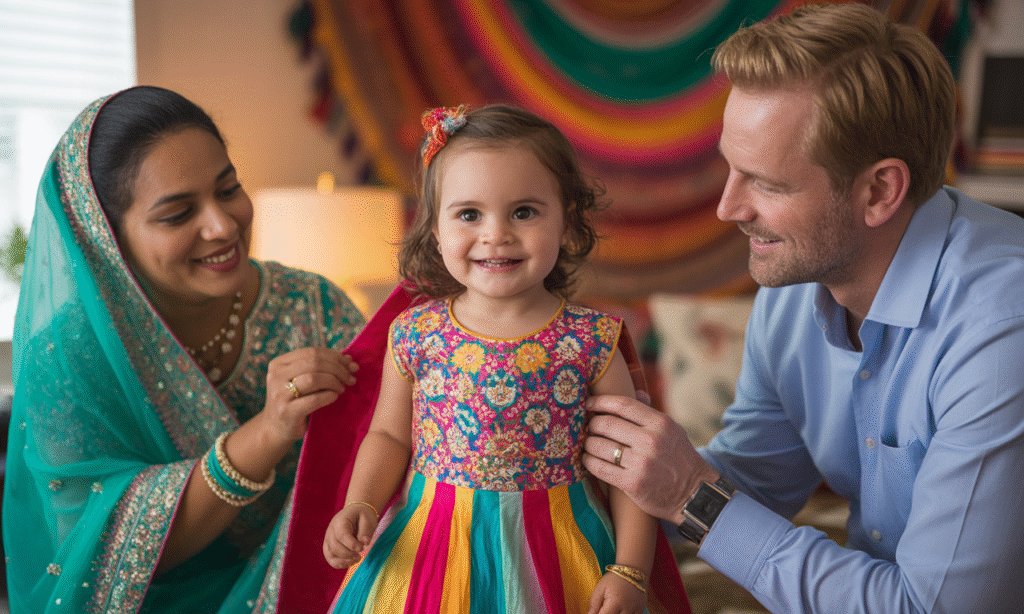Different Upbringings, Same Goals: Aligning Parenting Styles in Cross-Cultural Marriages

Introduction
Parenting is never one-size-fits-all. When you’re in a cross-cultural marriage, the challenges can multiply—not because either partner is doing something wrong, but because you’re both carrying deeply rooted beliefs from the families and cultures that raised you. Whether it’s about discipline, education, sleep routines, or even mealtime manners, different upbringings can create friction when you become parents.
But here’s the good news: You and your partner can build a unified parenting approach that honors both of your backgrounds—while also creating a new family culture that feels right for your children. This blog post will guide you through the emotional layers, practical tools, and communication strategies needed to align your parenting styles, even when you come from very different worlds.
1: Understanding the Roots of Your Parenting Beliefs
 Before you decide what’s “best” for your kids, you need to know where your instincts come from.
Before you decide what’s “best” for your kids, you need to know where your instincts come from.
We all carry subconscious parenting scripts shaped by our own childhoods. In a cross-cultural relationship, these scripts can differ wildly. Maybe one of you grew up in a collectivist culture where obedience and family unity were non-negotiable. Maybe the other had a more individualistic upbringing focused on independence and self-expression.
Neither approach is inherently right or wrong—they’re simply different. The first step toward unity is awareness. Talk openly with your partner about the rules, routines, and values that shaped your upbringing. What did your parents emphasize? How was affection shown? What was discipline like? What traditions still feel sacred to you?
💬 Pro Tip: Have this conversation before a conflict arises. The more proactive you are, the easier it will be to collaborate once parenting stress hits.
2: Spotting the Tension Points Early
 When the baby comes—or even before—parenting preferences show up fast.
When the baby comes—or even before—parenting preferences show up fast.
Do you want your baby to co-sleep or have their own crib? Will you use screen time as a tool or avoid it altogether? Should kids speak both languages fluently? These questions are no longer theoretical when real-life decisions are on the table.
Most conflict stems from assumed norms. One partner might think, “Of course we’ll celebrate Christmas,” while the other assumes the family will focus on Diwali or Eid. Even how you define “respectful behavior” can vary. For some, it’s saying “Yes ma’am.” For others, it’s eye contact and speaking your mind.
When disagreements arise, resist the urge to defend your default. Instead, pause and ask, “Where is this belief coming from? And what value is behind it?”
🔍 Example: If you believe kids should always greet elders with a bow or handshake, ask yourself: Is the goal respect, humility, or something else? Then find a culturally inclusive way to teach that value.
3: Creating a Shared Parenting Vision
 You won’t agree on everything—but you must align on the big things.
You won’t agree on everything—but you must align on the big things.
Sit down together and draft a family vision statement for your parenting. This isn’t about spelling out rules. It’s about clarifying your shared hopes for your children. What kind of character do you want to build? What values do you hope your children inherit? How do you want them to feel about their identity and heritage?
This exercise can be especially healing if either partner feels their culture is being overlooked. It creates space to intentionally honor both legacies in your home.
🎯 Vision Example:
“We want to raise kind, curious children who are proud of both their Indian and Irish roots. We value emotional safety, academic curiosity, and respect for elders—without using fear-based discipline.”
When you agree on the vision, individual parenting choices (like bedtime routines or holiday celebrations) have a context—and less room for power struggles.
4: Bridging Style Differences with Tools, Not Tension
 Once you understand your differences, it’s time to meet in the middle.
Once you understand your differences, it’s time to meet in the middle.
Here are practical strategies that help couples blend their parenting approaches without resentment:
1. Use the “Both-And” Approach
Instead of “either we do it your way or mine,” ask, “How can we incorporate both traditions?” For example, bedtime could involve both a bedtime story (Western tradition) and a blessing or lullaby from your cultural background.
2. Agree on the Framework, Flex on the Execution
Maybe you both want respectful kids. One of you leans toward time-outs, the other toward redirection. Rather than argue about tools, agree on what discipline means—then allow each other to choose methods that fit your personality and cultural norms.
3. Respect Each Other’s “Non-Negotiables”
Each partner should name 1–2 parenting values or traditions that feel essential to their identity. These should be honored unless they directly harm the child. When both sides feel seen, compromise comes easier elsewhere.
4. Model Curiosity for Your Kids
Children are watching how you handle cultural differences. When they see you ask questions, laugh at misunderstandings, or say, “That’s not how I grew up, but I’m open to trying it,” you’re teaching them emotional intelligence and cross-cultural respect.
5: When Tensions Boil Over—How to Repair Without Blame
 Even the most aligned couples will clash over parenting. The key is learning how to repair.
Even the most aligned couples will clash over parenting. The key is learning how to repair.
Instead of saying:
- “You’re being too soft on them!”
Try: - “I noticed you handled that situation differently than I would. Can we talk about what each of us was trying to teach?”
This opens the door for intentions to be shared, not just behaviors judged.
Use the “PAUSE” Method:
- P: Pause when emotions run high.
- A: Acknowledge your reaction (frustration, fear, confusion).
- U: Understand where your partner is coming from.
- S: Share your values—not just your anger.
- E: Explore a way forward together.
Couples who learn to disagree constructively often become more unified long-term than those who avoid hard conversations.
6: Building a New Family Culture
 You’re not just blending cultures—you’re creating a new one.
You’re not just blending cultures—you’re creating a new one.
One of the greatest gifts of cross-cultural parenting is the chance to form a family culture that’s richer, more inclusive, and more intentional than either of you had growing up.
You get to:
- Celebrate two sets of holidays.
- Introduce your kids to multiple languages.
- Teach flexibility, empathy, and resilience by example.
Don’t just aim for “meeting in the middle.” Aim for something even better: a home where your children feel safe, deeply loved, and connected to their heritage from both sides.
Let your children hear stories from both grandmothers. Let them cook dishes from both kitchens. Let them wrestle with big questions like “Why do we do things differently than other families?”—and let them know that this difference is a strength, not a flaw.
Final Thoughts: Same Team, Same Goal
 If you and your partner come from different upbringings, parenting won’t always be easy—but it can be powerful. With mutual respect, open dialogue, and shared vision, your differences become your strength.
If you and your partner come from different upbringings, parenting won’t always be easy—but it can be powerful. With mutual respect, open dialogue, and shared vision, your differences become your strength.
Remember: You are not adversaries in this journey. You are allies.
At the end of the day, your goal is the same—to raise happy, healthy, grounded kids who know they are deeply loved and culturally rooted.
And when that’s your North Star, even the hardest parenting decisions become opportunities to grow stronger—together.

